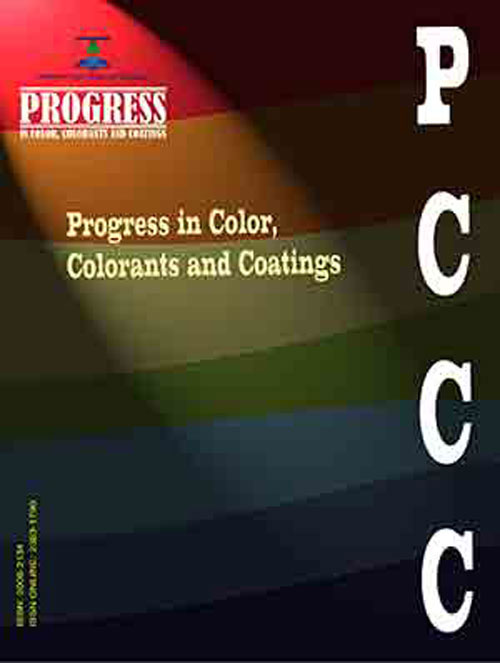فهرست مطالب
Progress in Color, Colorants and Coatings
Volume:6 Issue: 2, Summer 2013
- تاریخ انتشار: 1392/06/26
- تعداد عناوین: 7
-
-
Pages 67-79Dissolution of azo dyes derived from N-carboxylic acid-1،8- naphthalimide was studied in aqueous solutions containing formaldehyde condensation of naphthalenesulphonic acid and fatty alcohol ethylene oxide compound surfactants. The effect of additional hydroxyl group on chemical structure of dye on dissolution was also investigated. In addition، the effect of important factors on dissolution of used dyes in surfactant solutions such as the concentration of surfactants، temperature and time were considered. The results revealed that the dissolution rate of both dyes in formaldehyde condensation of naphthalenesulphonic acid was greater than the fatty alcohol ethylene oxide compound. In the same circumstance، the dissolution values of dyes indicated that dye 2 containing N-ethyl-n- (2-hydroxyethyl) aniline had more solubility than dye 1 containing N،N-diethylaniline. It may be attributed to the greater hydrophilicity of the dye 2 compared to dye 1. The results suggested that the dissolution of dyes in water containing surfactants was dependent on the chemical structure of dyes and the type of used surfactants. Prog. Color Colorants Coat. 6 (2013)، 67-79. © Institute for Color Science and Technology.Keywords: Dissolution, Hydroxyl group, Carboxylic Acid, 1, 8, Naphthalimide, Dye, Surfactant
-
Pages 81-86Agreen method for the synthesis of high-performance diketopyrrolopyrrole pigments using diethyl succinate in the presence of mixture of ionic liquids is reported. Although, alkaline condition is needed in the succinate ester route for synthesis of the pigments, in the present study, the replacement possibility of conventional organic base by mixture of [BMIM][OH] and [BMIM][BF4] ionic liquids was investigated. One of the points in this approach is the utilization of diethyl succinate, a commercially available and low-cost reagent instead of di-t-butyl or t-amyl succinate as bulky esters which are recommended in conventional methods. The obtained results were compared with the results of synthesis in the presence of each of ionic liquids solely with sodium t-amyloxide.Keywords: Ionic liquids, Diketopyrrolopyrrole, Pigment, Green synthesis
-
Pages 87-96A new polymerizable fluorescent sensor based on the photoinduced electron transfer (PET) has been synthesized for the selective determination of fluoride ions in DMF solutions. The sensing system was prepared by incorporating 4-Amino-1,8-naphthalimide derivatives containing thiourea side chain at the amino moiety (AFTN) as a neutral Fselective flourophore and was characterized by use of the DSC, FTIR, 1HNMR, 13CNMR and elemental analysis. The ability of AFTN to copolymerize with vinyl monomers of styrene by free radical copolymerization was demonstrated in order to design a potential polymer base flourophore sensor. The selectivity for F− among the halides is attributed mainly to the hydrogen-bond interaction in the receptor with F−. The results showed that this fluoroionophore could serve as a novel fluorescent sensor for further application. Prog.Keywords: Optical sensor, Fluoride ions, Fluorescence quenching, 4, Amino, 1, 8, Naphthalimide, Hydrogen bonds, Polymerizable
-
Pages 97-108The aim of this investigation was to study the relationship between activation factors and adsorption of cationic dye, methylene blue (MB), by activated bentonite. The adsorption index was investigated as a function of acid type, activation temperature and time. A commercial bentonite was selected as a starting material and the effect of activation agent concentration and heat treatment on MB adsorption were determined in a batch setup. The obtained results showed that the adsorption capacity of activated adsorbents by hydrochloric, sulfuric and nitric acids are not only higher than that for untreated bentonite but also this parameter depends on activation condition and acid concentration. The finding results were confirmed by the measurement of the specific surface area of adsorbents with nitrogen adsorption technique, FTIR spectroscopy and X-ray diffraction. Prog.Keywords: Methylene blue, Bentonite, Adsorption, Activation
-
Pages 109-117In the present study, two new organic dyes based on indigo were prepared and used as sensitizers in dye-sensitized solar cells. To this end, indoxyl was utilized as the electron donor and cyanoacrylic acid as the electron acceptor anchoring groups. These dyes together with their corresponding intermediates were purified and characterized by FTIR, 1HNMR, 13CNMR, elemental analysis and UV-Visible analytical techniques. Spectrophotometric evaluations of the prepared dyes in solution and on a TiO2 substrate were carried out in order to assess changes in the status of the dyes. The results show that the dyes form jtype aggregates on the TiO2 substrate. Finally, dye sensitized solar cells were fabricated in order to determine the current density/ photovoltage curves and conversion efficiencies of each dye. Prog.Keywords: Indigo, Dye, sensitized solar cells, Sensitizers, Photovoltaic materials, Conversion efficiencies, Photocurrent, photovoltage curves
-
Pages 119-128In this study, a series of epoxy/silica nanocomposites were prepared by using nano silica particles which had different surface modifications. The morphology of the nanocomposite coatings was characterized by scanning electron microscopy (SEM). The effects of the hydrophilic and hydrophobic feature of the nano particles on the Tg and anticorrosive properties of nanocomposite coatings were evaluated by DSC and EIS instruments. It was observed that the presence of the hydrophobic nano silica particles affected the curing and cross linking density of the organic coatings and consequently reduction in corrosion resistance of nanocomposite coatings. On the other hand, hydrophilic nano composite coatings showed better corrosion resistance even after 60 days immersion in 3.5% NaCl solution in comparison to pure epoxy coating. Prog.Keywords: Corrosion, Coating, Nano silica, Epoxy
-
Pages 129-139This paper studies the application of principal component analysis, multiple polynomial regression, and artificial neural network techniques to the quantitative analysis of binary mixture of dye solution. The binary mixtures of three textile dyes including blue, red and yellow hues were analyzed by PCA-Multiple polynomial regression and PCA-artificial neural network methods. The obtained results indicate that the accuracy of PCA-artificial neural network technique is higher than PCA-Multiple polynomial regression and normal spectroscopy methods. The PCA-artificial neural network technique is applicable for dye concentration bicomponent solution with both overlapping and non-overlapping spectra. The developed method can be a practical solution to quantitative analysis of binary mixture of dye solutions with overlapping. Prog.Keywords: Dye concentration prediction, Principal component analysis, Neural network, Polynomial regression, Spectrophotometry


